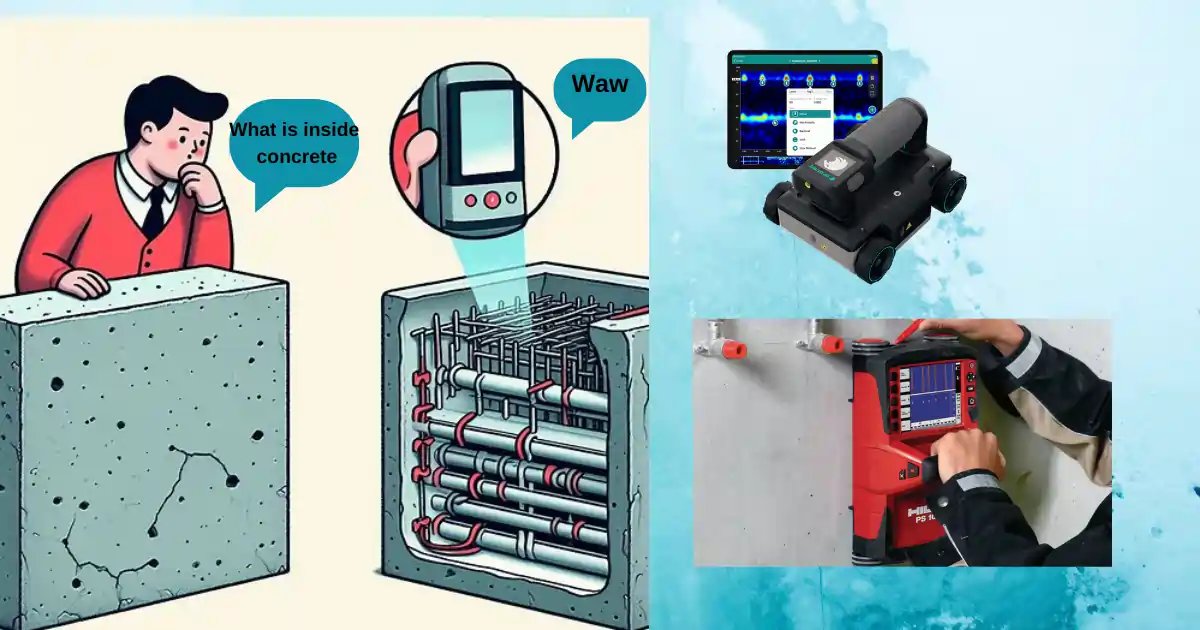Ground penetrating radar (GPR) is an incredibly useful non-destructive testing technique for inspecting concrete structures in the construction industry. GPR allows you to essentially see through the concrete to visualize what is inside – things like rebar, post-tension cables, conduits, and concrete quality issues such as voids,lamination,corrosion,cracks or other defects. GPR is versatile technology that is also applied in archeological investigations,utilities locating and environmental assessments.
How GPR Works
GPR uses electromagnetic waves in the microwave band of the radio spectrum to detect objects and changes in material properties below the surface. A GPR system has a transmitter antenna that emits pulses of electromagnetic waves into the concrete. When the waves hit something with different electrical properties like metal or plastic, part of the signal is reflected back to a receiver antenna. The difference of electrical properties denoted by dielectric permitivity with concrete of those materials makes its application suitable.

At perpendicular objects, the wave reflects back at different distance forming an hyperbola. Metallic targets have 100% reflection and air 40%.
By analyzing the reflections and their timing, GPR can map out the location of embedded objects like rebar or detect areas of differing density that may indicate defects or voids. The depth penetration depends on the frequency of the waves used, with lower frequencies traveling deeper but providing less resolution.
Interpreting GPR Data
The raw GPR data appears as wavy lines called “scans” that represent the electromagnetic reflections over time as the antenna is scanned across the surface. Hyperbolic shapes in the scan data indicate the presence and depth of objects below the surface.
GPR data can be of three types. The types of data depend on the way the data is taken in the the x-y-z dimensions.
To better visualize what the scans are detecting, the data is processed into easier to interpret formats:
– A-scans are taken at fixed position in x,y as shown in the figure.

– B-scans consist of A-scan signals taken at regular intervals along x axis that show a cross-sectional slice view like a core sample

– C-scans provide a horizontal depth slice at a given depth, it is a three dimensional scan composed of simultaneous B scans along the xy plane. It is not much used since y axis is the most desired in construction because it is takes much time and it is costly.

– 3D volumes allow rotating and slicing through the data
-migrated view allows to see the object more clearly because the image becomes unfocused due to the parabola.
Advanced GPR systems use an array of multiple antennas to collect densely sampled 3D data over a large area much faster than single scans. They also utilize a wide range of frequencies through stepped frequency continuous waveform (SFCW) technology to balance deep penetration and high resolution in a single pass.
Why GPR scanning of concrete is needed
As structures age renovation needs becomes necessary. The drilling of concrete cores should be done with certainity of not damaging rebars, pipes and ducts. This is necessary because damages can incur more cost, delay or jeopardise projects.
Applications in Construction
GPR is commonly used on construction sites to avoid hitting unknown objects before coring or cutting into concrete slabs and walls. Locating embedded rebar, conduits, post-tension cables, etc. first prevents serious damage.
It’s also invaluable for assessing the internal condition of aging concrete structures like bridge decks or parking garages. GPR can map out rebar layouts,has potential to check for delamination or voids, and estimate rebar corrosion – all without requiring demolition.
On new construction projects, GPR provides quality control by verifying the as-built rebar, cable, and conduit placement matches design plans before pouring concrete. This allows correcting any issues early on rather than later after the concrete has cured.
With its ability to visualize what’s embedded within concrete safely and non-destructively, ground penetrating radar has become an essential inspection tool throughout the construction industry lifecycle from design to maintenance. As GPR technologies continue advancing with improved resolution, faster scanning, and better data visualization, we can only expect these “concrete xray” capabilities to become even more indispensable on job sites.
There are several GPR scanning systems in the market which have varying features. The most commnly used brands include Proceq, IDS Georadar C-Thrue,GSSI XT Mini and Flex,mala CX,Hilti PS1000

They have variable characteristics in relation to scanning depth, resolution, portability, and overall cost. It is necessary to choose the most suitable scanners by considering their advantages and drawbacks of various GPR scanning brands. The project requirements, budget constraints, and user expertise are necessary factors to count when selecting suitable scanners.
Pros and Cons of GPR Concrete Scanning
Pros of GPR concrete scanning:
1. Non-destructive Testing:
GPR (Ground Penetrating Radar) allows for the evaluation of concrete structures without causing any damage, preserving the structural integrity of the tested material .
2. Detection Capabilities:
It is particularly effective in locating and mapping near-surface reinforcement bars due to the significant difference in electric properties between concrete and metal.
3. Versatility:
GPR can be used on a variety of structures with different properties, shapes, and sizes. It is suitable for all structures types walls, slabs, beams or roof.
4. Data Presentation:
Modern GPR devices offer multiple data presentation formats (A-scan, B-scan, and C-scan), providing comprehensive visualizations of the internal structure of concrete.
5. Depth Estimation:
Techniques like hyperbola fitting allow for the estimation of signal velocity and the approximation of the depth of reinforcement or other reflectors within the concrete.
6. Real time results:
GPR scanning provides immediate results for timely feedback and adjustment in planning.
Cons of GPR Concrete Scanning:
1. Limited depth penetration: The depth of penetration for GPR is limited, typically ranging from a few inches to a few feet, depending on the concrete properties and the frequency of the GPR system.
2. Interference from certain materials: Certain materials within the concrete, such as steel reinforcement or highly conductive materials, can cause signal attenuation or reflections, potentially affecting the accuracy of the data.
3. Moisture Sensitivity: High moisture content in concrete can hinder GPR signal penetration, potentially leading to inaccurate readings or missed objects
4. Surface conditions: Rough or uneven concrete surfaces can impact the quality of the GPR data, requiring additional surface preparation or data processing.
5. Initial investment: GPR equipment and software can be expensive, especially for more advanced or specialized systems, which may not be cost-effective for small-scale projects.
6. Difficulty with Dense Reinforcement:
In structures with heavy reinforcement, detecting lower layers of bars can be challenging. GPR is less effective in concrete with very closely spaced rebar (less than 7 cm) or steel fiber-reinforced concrete due to limited horizontal resolution.
7. Data Interpretation:
The interpretation of GPR data requires significant expertise. The raw data must be accurately analyzed to make correct assessments, which can be complex and time-consuming.
8. Ambiguous Results:
Field tests have shown that while GPR is excellent for near-surface assessments, results can be ambiguous for deeper layers. Further tests and evaluations are needed to improve the reliability of deeper scans.
Overall, GPR concrete scanning is a valuable tool for non-destructive evaluation and assessment of concrete structures, providing important information for maintenance, repair, and construction projects. However, it is essential to consider the limitations and site-specific conditions to ensure accurate and reliable results
Sources:
http://www.diva-portal.org/smash/get/diva2:1280320/FULLTEXT02.pdf
screeningeagle.com

